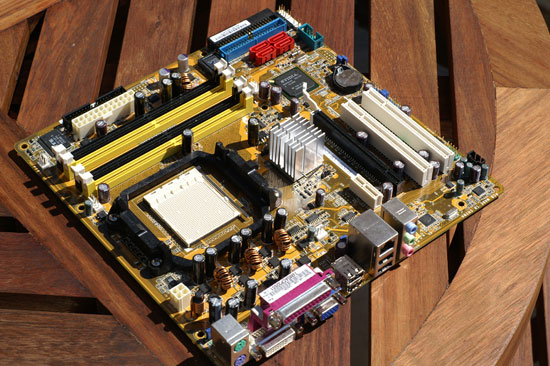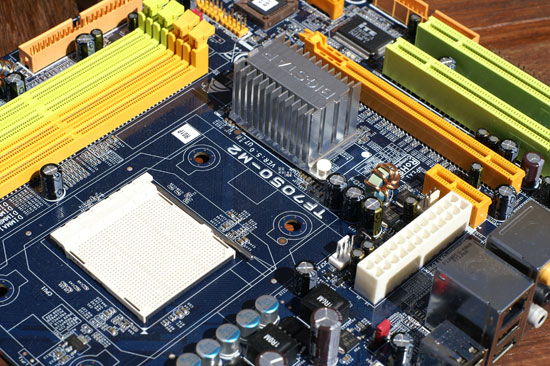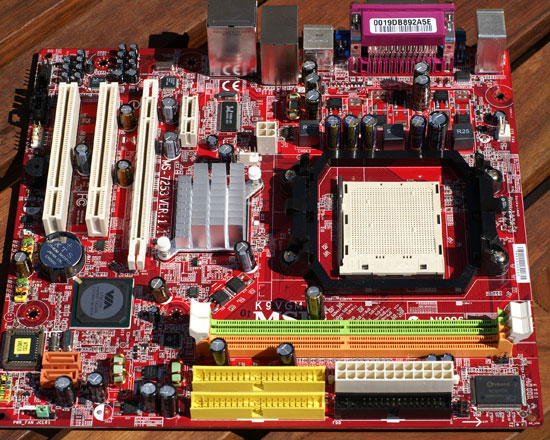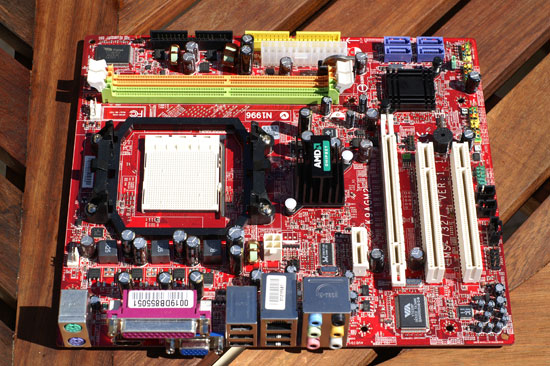Midrange CPU Roundup: It's Time to Buy
by Anand Lal Shimpi on September 28, 2007 2:00 AM EST- Posted in
- CPUs
How Cheap Can You Go? AMD Chipset Comparison
When looking at AMD chipsets you'll notice that we chose a different benchmark; instead of SYSMark 2007 we used PC WorldBench 6 - the reason being that none of the NVIDIA GeForce 6xxx series chipsets could complete a single SYSmark run. The new AMD 690 chipsets and the GeForce 7050 had no problem, but the older 6xxx chipsets were too finicky.

Performance wise, there's really not much to see on the AMD side of things. All of the chipsets are within a two point spread, and figuring margin of error at one point we can basically call this as close to a tie as we're likely to get. Honestly, other than the VIA chipsets, we had the most problems with NVIDIA GeForce 6xxx based motherboards. They all seem to be extremely picky about component choices, especially when it came to memory and power supply selection.

A finicky motherboard, stay away from the GeForce 6000 series boards.
We ran into one problem where our GeForce 6150 motherboard wouldn't POST without a PCI Express graphics card installed unless we switched power supplies. Memory selection is also critical for ensuring proper operation, and these motherboards are very picky about what they will and won't work with. We'd strongly suggest consulting approved memory devices/vendors if you do end up going with any GeForce 6xxx based motherboards, or better yet, opt for something based on the AMD 690 or NVIDIA GeForce 7xxx chipsets.

Biostar was the first company to send us a GeForce 7050 based motherboard and it worked flawlessly.
Although we tested them, we couldn't provide any performance results for any of the VIA chipsets currently offered for either AMD or Intel. Not only is Vista horrendously unstable with Aero enabled on any of VIA's integrated graphics platforms, but even with Aero off we couldn't get any of our performance suites to complete.

Stay away from VIA, there are simply far better options these days.
Manufacturers always ask why people have such good experiences with Intel's integrated chipsets, despite the fact that they have the worst graphics performance out of the lot. In our experience testing these platforms over the past couple of months, the Intel platforms always just worked and honestly it hasn't been until fairly recently that AMD has been able to say the same. AMD's 690G and 690V chipsets were just as seamless to install and set up as Intel's. The same can be said about NVIDIA's 7xxx series, so if you're going AMD we'd suggest picking from those three and staying away from the rest.

Our only real complaint about the 690G/690V is the driver bundle; there are far too many non-driver items that get installed by default. While not as bad as default spyware, when we download a chipset driver we don't expect to have to uncheck options for free games or Earthsim. Take a look around AMD; drivers shouldn't be bundled with this sort of stuff.
NVIDIA isn't totally off the hook either, as finding drivers for its 7xxx series of chipsets is impossible on the website. We had to download the nForce drivers for the 680a chipset and then GeForce 7 graphics drivers separately. What happened to the days of clean, single file unified drivers for everything NVIDIA? Perception is everything, and NVIDIA has done a lot of regressing with the perceived quality of its drivers as of late. In fact, it's only very recently that NVIDIA's graphics drivers - often considered the gold standard - reached the point where performance and features under Vista are up to snuff.
When looking at AMD chipsets you'll notice that we chose a different benchmark; instead of SYSMark 2007 we used PC WorldBench 6 - the reason being that none of the NVIDIA GeForce 6xxx series chipsets could complete a single SYSmark run. The new AMD 690 chipsets and the GeForce 7050 had no problem, but the older 6xxx chipsets were too finicky.

Performance wise, there's really not much to see on the AMD side of things. All of the chipsets are within a two point spread, and figuring margin of error at one point we can basically call this as close to a tie as we're likely to get. Honestly, other than the VIA chipsets, we had the most problems with NVIDIA GeForce 6xxx based motherboards. They all seem to be extremely picky about component choices, especially when it came to memory and power supply selection.

A finicky motherboard, stay away from the GeForce 6000 series boards.
We ran into one problem where our GeForce 6150 motherboard wouldn't POST without a PCI Express graphics card installed unless we switched power supplies. Memory selection is also critical for ensuring proper operation, and these motherboards are very picky about what they will and won't work with. We'd strongly suggest consulting approved memory devices/vendors if you do end up going with any GeForce 6xxx based motherboards, or better yet, opt for something based on the AMD 690 or NVIDIA GeForce 7xxx chipsets.

Biostar was the first company to send us a GeForce 7050 based motherboard and it worked flawlessly.
Although we tested them, we couldn't provide any performance results for any of the VIA chipsets currently offered for either AMD or Intel. Not only is Vista horrendously unstable with Aero enabled on any of VIA's integrated graphics platforms, but even with Aero off we couldn't get any of our performance suites to complete.

Stay away from VIA, there are simply far better options these days.
Manufacturers always ask why people have such good experiences with Intel's integrated chipsets, despite the fact that they have the worst graphics performance out of the lot. In our experience testing these platforms over the past couple of months, the Intel platforms always just worked and honestly it hasn't been until fairly recently that AMD has been able to say the same. AMD's 690G and 690V chipsets were just as seamless to install and set up as Intel's. The same can be said about NVIDIA's 7xxx series, so if you're going AMD we'd suggest picking from those three and staying away from the rest.

Our only real complaint about the 690G/690V is the driver bundle; there are far too many non-driver items that get installed by default. While not as bad as default spyware, when we download a chipset driver we don't expect to have to uncheck options for free games or Earthsim. Take a look around AMD; drivers shouldn't be bundled with this sort of stuff.
NVIDIA isn't totally off the hook either, as finding drivers for its 7xxx series of chipsets is impossible on the website. We had to download the nForce drivers for the 680a chipset and then GeForce 7 graphics drivers separately. What happened to the days of clean, single file unified drivers for everything NVIDIA? Perception is everything, and NVIDIA has done a lot of regressing with the perceived quality of its drivers as of late. In fact, it's only very recently that NVIDIA's graphics drivers - often considered the gold standard - reached the point where performance and features under Vista are up to snuff.










44 Comments
View All Comments
Darth Farter - Friday, September 28, 2007 - link
why not the cool & quiet idle power numbers?seeing they're running at full speeds at idle is besides the point of an "idle" measurement in this age with powersavings...
tnx though on the bios update request from asus... I want to tweak my timings too.
Anand Lal Shimpi - Friday, September 28, 2007 - link
C&Q and EIST were both enabled for the idle and load power numbers. Actually all the benchmarks were run with those settings enabled.Take care,
Anand
archcommus - Friday, September 28, 2007 - link
I realize the benchmarks are run at 1024x768 to make the tests CPU-limited, does that mean all, or at least most, of the extra horsepower needed for resolutions above that comes from the GPU? If so, does that mean I could run games at 1280x1024 well with a high-end card and one of the AMD CPUs from this round-up? Or would that be a bad match-up? If that would work it's an appealing upgrade path alternative to jumping platforms.nosfe - Friday, September 28, 2007 - link
why not color code those performance graphs so that we can easily see which processors are competing at the same price